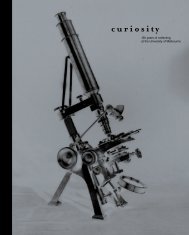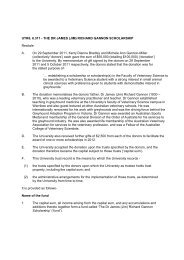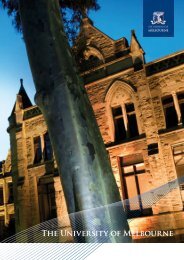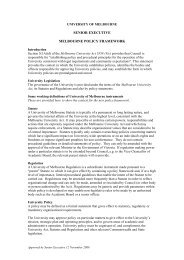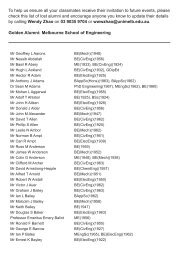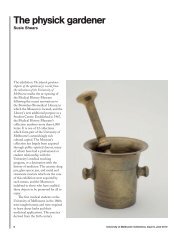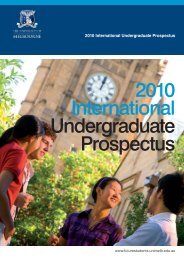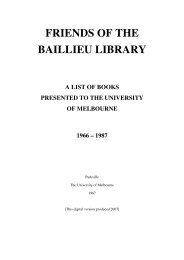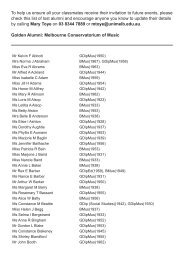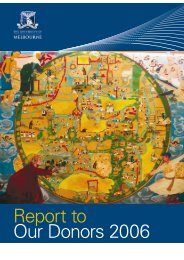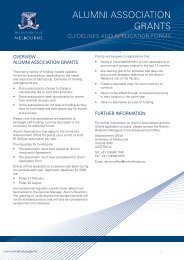annual report/2006 - University of Melbourne
annual report/2006 - University of Melbourne
annual report/2006 - University of Melbourne
You also want an ePaper? Increase the reach of your titles
YUMPU automatically turns print PDFs into web optimized ePapers that Google loves.
Growing Esteem/<br />
In December 2005 Council approved a new strategic direction for the <strong>University</strong><br />
– Growing Esteem. While affirming the aspiration to be one <strong>of</strong> the finest<br />
universities in the world, the new strategic direction sets three priorities for<br />
the <strong>University</strong> – research and research training, learning and teaching and<br />
knowledge transfer. The <strong>University</strong> adopted the metaphor <strong>of</strong> a triple helix, an<br />
image intended to capture the three strands <strong>of</strong> the Growing Esteem strategy<br />
intertwined, each reinforcing the others.<br />
Introducing the <strong>Melbourne</strong> Model<br />
Central to the Growing Esteem strategy is the introduction<br />
<strong>of</strong> the `<strong>Melbourne</strong> Model’, a pioneering model in Australia<br />
and the most significant change to the <strong>University</strong>’s<br />
curriculum in its 154-year history. Over time, pr<strong>of</strong>essional<br />
education will move to the postgraduate level, adopting<br />
a familiar international approach. Graduate pr<strong>of</strong>essional<br />
study or research Masters and PhD degrees will follow<br />
three-year undergraduate degrees which stress both depth<br />
and breadth – equipping students for lives and careers<br />
in which knowledge boundaries are more permeable,<br />
pr<strong>of</strong>essional practice requires multidisciplinary<br />
understanding and knowledge is rapidly renewed.<br />
As the decade-long transfer to this <strong>Melbourne</strong> Model<br />
begins in 2008, there will be changes to the student<br />
pr<strong>of</strong>ile. Undergraduate numbers will decline modestly,<br />
allowing a shift to more graduate education, better<br />
student and staff ratios over time, and an eventual easing<br />
<strong>of</strong> overcrowding on campus.<br />
As a research institution, <strong>Melbourne</strong> will open new paths<br />
to scientific understanding, support critical and creative<br />
endeavour and provide an outstanding research training<br />
experience for future leaders in academia, government<br />
and industry.<br />
<strong>Melbourne</strong> will continue to support a comprehensive<br />
array <strong>of</strong> disciplines, while also directing additional funding<br />
towards disciplines <strong>of</strong> strategic importance in which the<br />
<strong>University</strong> is currently or potentially a world-leader.<br />
The third strand <strong>of</strong> the helix, knowledge transfer,<br />
articulates the goal <strong>of</strong> dynamic exchange and partnerships<br />
with the broader community. As a public institution,<br />
the <strong>University</strong> must ensure that core research and<br />
teaching activities contribute to, and absorb lessons<br />
from communities beyond campus boundaries.<br />
Provision <strong>of</strong> higher education is now an international<br />
enterprise. The <strong>University</strong> <strong>of</strong> <strong>Melbourne</strong> has been<br />
fortunate in finding an early audience for Australian<br />
higher education, but must assume the global race<br />
will get tougher. New competitors are opening in its<br />
traditional markets.



